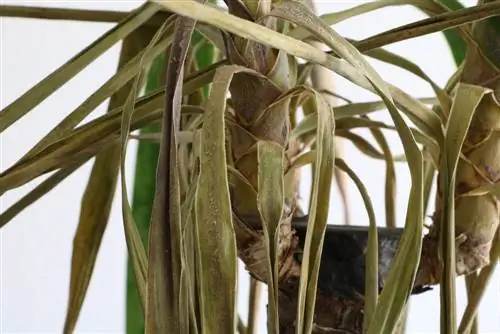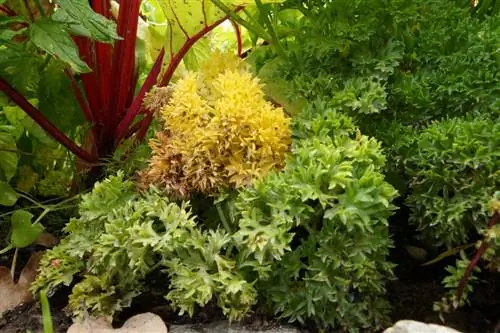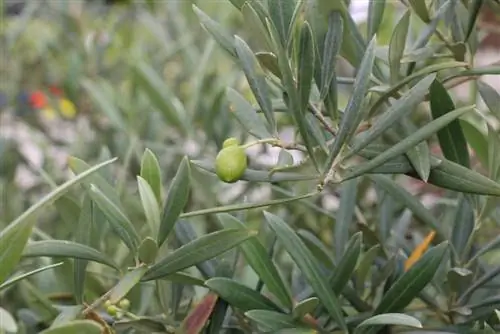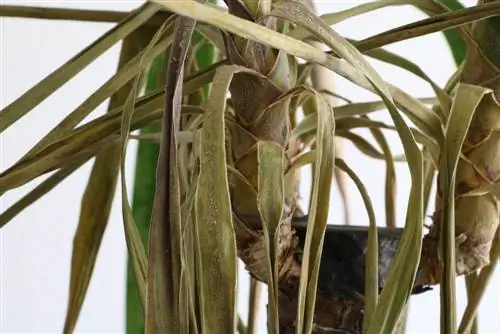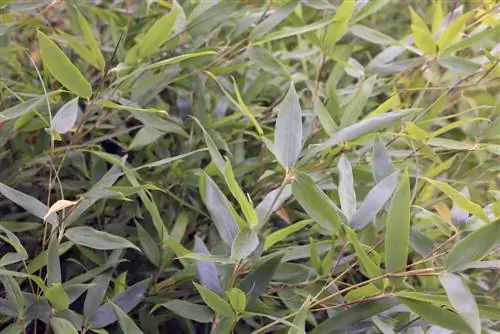- Author admin [email protected].
- Public 2024-01-17 10:10.
- Last modified 2025-01-24 12:45.
Houseplants make a significant contribution to improving the indoor climate, but their lifespan is often shorter than it should be. The causes are varied, such as incorrect care or diseases or pests that were noticed too late and then the plant can often no longer be saved.
The first signs of problems are usually yellow or brown leaves, although a distinction must be made as to whether these are isolated leaves dying, which is completely normal, or whether significantly more leaves are showing discoloration. As soon as the discoloration occurs in an abnormal amount, countermeasures should be taken as there is still a good chance of saving the plant.
Possible malicious images
It is important to make precise distinctions when it comes to the damage, because often the entire leaf is not affected, but only the tips or yellow or brown spots appear at certain points.
Brown leaf tips
Brown leaf tips can have two possible causes, the most common being that the air in the room is too dry. This problem therefore occurs more often in the winter months when there is too little ventilation and too much heating or when the plants are directly above the radiator. The problem can be solved simply by changing the location or increasing the humidity by placing a bowl of water on the heater. In addition to the dry air, an excess of mineral s alts can also be the cause, whereby the fertilizer application with mineral s alts must be reduced and the plant may have to be repotted in soil that is poorer in mineral s alts so that the household balance is balanced again.
Yellow or brown edges
Too dry air or too high a lime content in the soil can also be to blame here. However, this damage is much more often due to over-fertilization or too frequent watering. In this case, it is essential that the plant is repotted and watered less in the future.
Tip:
If you often have problems with houseplants due to overwatering, you should cover the bottom of the pot with clay granules. This allows the excess water to drain away and at the same time water can be stored, which is slowly released to the plants.
Yellow-green leaves
It is also important to act quickly here, as this damage usually affects the entire plant within a very short time and not just the older leaves. This problem often occurs in regions with very hard water because there is an excess of lime. The substrate of the affected plant also needs to be renewed because the lime has also settled in the soil. In the future, care should be taken to use low-lime fertilizers and water. Since water is often a problem and it is not possible to water with low-lime water, the plant's soil should be renewed at least once a year.

Yellow falling leaves
This problem also occurs more frequently in winter and often affects plants that prefer very bright locations. These plants are often exotic plants from dry and warm regions that have a difficult time in this country in winter because they lack light unless they are near the windows and it often gets too cold for them in a room is not heated regularly. In addition, many people forget that evergreen houseplants also have a resting phase in winter and that they should not be provided with excessive water during this time. Therefore, watering should be reduced immediately if excessive leaves fall off.
Brown leaves
Compared to the damage caused by the brown tips, the leaves here turn brown and die within a few days. The causes for this can be varied and it could be, for example, frost damage. This damage can occur quickly, especially in heat-loving exotic plants - ten minutes of ventilation is often enough for frost damage to occur. There's not much you can do here, only the affected parts of the plant can be removed, otherwise you have to wait and see how extensive the damage is. Leaves that turn brown quickly can also be caused by incorrect watering habits and excessive moisture can cause root rot to form. In this case, the plant should be quickly repotted into a new substrate, but if there is root rot, the chances of saving the plant are extremely slim.
Tip:
Root rot is a common problem with houseplants, as it is better to water a lot once rather than in small amounts over and over again. However, houseplants should never be left in water permanently; the planter should only be used as an overflow protection.
Pale to yellowish leaves
If the leaves, especially the young leaves, lose their color quickly, this is often an indication of a deficiency. This damage is often associated with stunted growth because there are not enough nutrients for good development. A fertilizer specifically for houseplants should be used here, if possible in liquid form. The plants can absorb this much more quickly, which is particularly important if deficiency symptoms occur. So that there is no shortage of nutrients, long-term fertilizers can be used in solid form, which then often only have to be added to the substrate once a month.
Frequently asked questions
Should affected leaves be removed?
Basically, the leaves should only be removed when they simply fall off the plant. If they are cut off when they are still supplied with water, this will cost the plant unnecessary energy to close the open wounds, although it would need this energy much more for regeneration.
How do I avoid watering too much or too little?
Watering is always a real problem with houseplants, because either too much or too little is watered. In addition to drainage with clay granules, it is therefore advisable to add a hydrometer to the substrate. This shows how moist the soil is and you can immediately see whether it needs to be watered again. In addition, plants should not be provided with too much water, especially before the holiday, as they can survive a dry period much better than a phase with too much water.
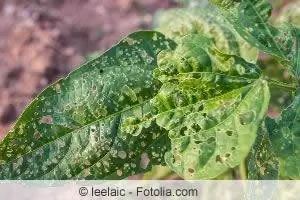
What you need to know about leaf discoloration on houseplants
- Brown leaf edges and brown leaves can be a sign of used soil. The plant needs a new planting substrate. It needs to be repotted.
- Often the soil is simply too moist or too dry. You should look up the care instructions for the plants and follow them.
- Rolled and limp leaves indicate a lack of water. If you don't water, the leaves will also turn brown.
- If too little is constantly watered, the tips of the leaves will turn brown. Immersion baths help against this.
- Brown leaf tips can also indicate the wrong location, usually too close to the heater. The tips can be carefully cut off.
Tip:
But you have to leave a narrow seam so that the interface doesn't dry out again.
- The humidity is usually too low. Most tropical houseplants require 80 to 90 percent humidity.
- Yellow leaves often indicate a nitrogen deficiency. This can be remedied by adding nitrogen fertilizer.
- An incorrect location can also lead to yellow leaves. It also indicates incorrect temperatures, either too high or too low.
- On palm trees, yellow leaves often indicate incorrect watering. They are usually watered too much.
- Palm trees are actually very robust. What they cannot tolerate is standing water. Wait until the top layer of soil has dried before watering again.
- Planters should be checked for standing water. This definitely needs to be drained.
- On palm trees, yellow leaves can also indicate a nutrient deficiency. This usually happens with very small planters.
- In addition, many plants react to low humidity with yellow leaves. Spraying the plants regularly with water helps.
- In some plants, yellow leaves indicate an iron deficiency (chlorosis). It is caused by iron and magnesium deficiency.
- An increased soil pH is usually to blame for yellow leaves. This prevents the absorption of iron and magnesium.
Tip:
You can change this by repotting and adding iron and magnesium fertilizer.
Bright leaves with green leaf veins indicate an iron deficiency. If this is the case with your plants, you can add iron chelate to the irrigation water
Conclusion of the editors
There can often be several causes for yellow or brown leaves on houseplants. It's not always easy to find out the right reason. It's best to look up what the plants require in terms of location, planting substrate and care. Then you can see whether you can offer all of this or whether something needs to be changed.
The drying of the leaves is often a completely natural process or an aging process. Dried parts are cut off from the plant. You have to be careful not to damage the he althy tissue of the leaves.

